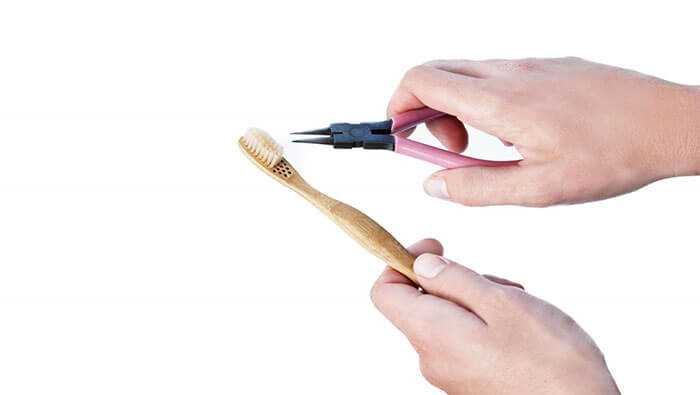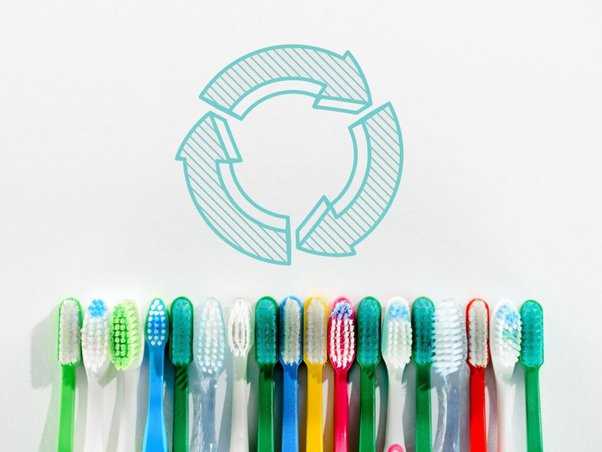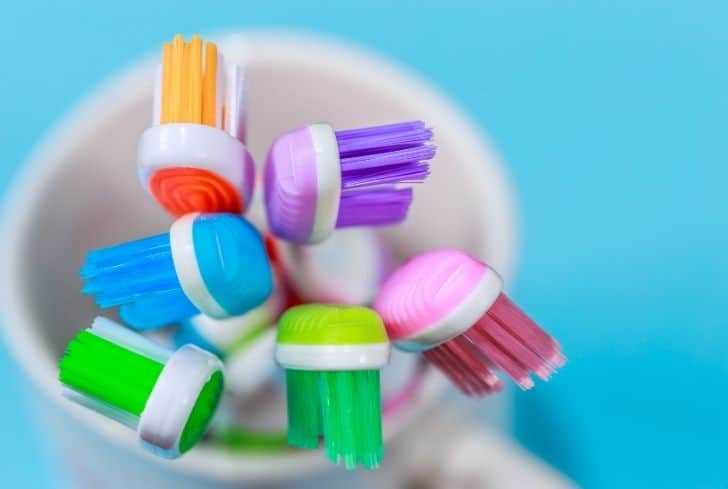
Toothbrushes play a vital role in our daily oral hygiene routine. They help us maintain clean and healthy teeth and gums. However, have you ever wondered what happens to all those toothbrushes once we’re done with them? Unfortunately, most toothbrushes are not recyclable, and this poses a significant environmental challenge.
A typical toothbrush is made of several materials that are difficult to separate and recycle. The handle is usually made of plastic, while the bristles are made of nylon or another synthetic material. Additionally, toothbrushes often contain metal staples or other small metal parts that are not accepted in most recycling facilities. All these different materials make it nearly impossible to recycle toothbrushes using conventional recycling methods.
Another reason why toothbrushes are not recyclable is their small size and shape. Recycling facilities are designed to process large quantities of materials, such as plastic bottles or cardboard boxes. Toothbrushes, on the other hand, are small and lightweight, making it challenging for them to be properly sorted and processed in recycling plants. As a result, most toothbrushes end up in landfills, where they can take hundreds of years to decompose.
Despite the challenges of recycling toothbrushes, there are some alternative options available. Some companies have started producing toothbrushes with replaceable heads, reducing the amount of waste generated. Additionally, there are eco-friendly toothbrushes made from biodegradable materials, such as bamboo. These options provide a more sustainable alternative to traditional toothbrushes and can help reduce our environmental impact.
In conclusion, toothbrushes are not recyclable due to the complex mix of materials they are made of, their small size, and the limitations of recycling facilities. However, by exploring alternative options and making conscious choices about the products we use, we can minimize our impact on the environment and work towards a more sustainable future.
- The Composition of Toothbrushes
- Handle
- Bristles
- Plastic Types in Toothbrushes
- The Challenges of Toothbrush Recycling
- 1. Materials Composition
- 2. Small Size
- Contamination Issues
- Alternative Disposal Options
- The Availability of Recycling Facilities
- The Challenges of Recycling Toothbrushes
- Promoting Alternative Toothbrush Options
- Alternatives to Traditional Toothbrushes
- 1. Bamboo Toothbrushes
- 2. Electric Toothbrushes
- 3. Silicone Toothbrushes
- 4. Natural and Biodegradable Bristles
- Q&A:
- Why are toothbrushes not recyclable?
- Are there any alternatives to plastic toothbrushes?
- What happens to toothbrushes after we throw them away?
- Can toothbrushes be recycled in any way?
- What can we do to reduce toothbrush waste?
- Why are toothbrushes not recyclable?
The Composition of Toothbrushes
To understand why toothbrushes are not recyclable, it is important to examine their composition. Toothbrushes are typically made up of different materials, each serving a specific purpose in their design.
Handle
The handle of a toothbrush is usually made from a type of plastic called polypropylene. This plastic is chosen for its durability, flexibility, and ability to withstand the moisture and fluctuating temperatures often encountered in a bathroom environment.
Polypropylene is not widely accepted for recycling because it is difficult to break down and recycle into new products. The process typically requires specialized equipment and facilities, making it impractical in most recycling systems.
Bristles
The bristles of a toothbrush are traditionally made from nylon, which is a synthetic material. Nylon bristles are preferred for their strength, flexibility, and ability to effectively clean teeth and gums.
While nylon can technically be recycled, the bristles themselves are too small and lightweight to be easily sorted and separated during the recycling process. This often results in the bristles being sent to landfills or incinerated, rather than being recycled.
Additionally, many toothbrushes have bristles that are fused into the handle, making it even more challenging to separate the different materials for recycling.
Some toothbrushes use alternative materials for the bristles, such as biodegradable or compostable options. However, these materials may not be as effective at cleaning teeth, and their environmental benefits can be offset by the resources required to produce them.
Overall, the composition of toothbrushes, with their mix of plastic handle and small bristles, makes them difficult to recycle effectively within current recycling systems.
Plastic Types in Toothbrushes
Toothbrushes are typically made from plastic materials, which can vary depending on the brand and type of toothbrush. The most common plastic types found in toothbrushes include:
- Polypropylene (PP): This type of plastic is often used for the handle of toothbrushes due to its durability and resistance to moisture. It is a commonly used plastic in various household items.
- Nylon (PA): The bristles of toothbrushes are commonly made from nylon, which is known for its flexibility, strength, and ability to be easily cleaned. Nylon is a widely used synthetic material in various industries.
- Polyethylene (PE): Some toothbrushes may have rubberized grips made from polyethylene, a plastic that provides a soft and comfortable texture for better grip and control while brushing.
These plastic materials are durable and long-lasting, which is important for maintaining the quality and effectiveness of a toothbrush. However, the drawback of these plastic types is that they are not easily recyclable. This means that toothbrushes often contribute to plastic waste and end up in landfill sites or the environment, where they can take hundreds of years to decompose.
Efforts are being made to develop alternative materials for toothbrushes that are more sustainable and eco-friendly. Some companies have started producing toothbrushes with handles made from bamboo or other biodegradable materials to reduce the environmental impact.
It is important for individuals to be aware of the plastic waste generated by toothbrushes and explore more environmentally friendly options, such as using toothbrushes with replaceable heads or recycling programs specifically designed for toothbrushes.
The Challenges of Toothbrush Recycling
While it may seem like a simple item, toothbrushes actually pose a number of challenges when it comes to recycling. These challenges can make it difficult for toothbrushes to be recycled effectively and contribute to the overall problem of plastic waste.
1. Materials Composition
Toothbrushes are typically made from a combination of different materials, including plastic handles and nylon bristles. These different materials can be difficult to separate during the recycling process, as they often require different recycling methods.
Plastic handles are usually made from a type of plastic called polypropylene (PP), which is not always easily recyclable. Additionally, the nylon bristles are made from a material called nylon 6, which also presents challenges for recycling due to its durability and resistance to degradation.
The complex composition of toothbrushes makes it difficult for recycling facilities to effectively process them, leading to lower recycling rates for this item.
2. Small Size

Toothbrushes are relatively small in size compared to other plastic items, such as bottles or containers. This small size makes them more likely to get lost or sorted incorrectly during the recycling process, as they can easily be mixed in with other waste or sorted out as contaminants.
Furthermore, the small size of toothbrushes can make it impractical and expensive to collect and recycle them on a large scale. The cost of collecting and processing these small items often outweighs the value of the recycled materials they yield, making it economically unviable for many recycling facilities.
Overall, the challenges posed by the materials composition and small size of toothbrushes make it difficult to effectively recycle them. As a result, many toothbrushes end up in landfills or as litter, contributing to the growing problem of plastic waste in our environment.
Contamination Issues
One of the main reasons why toothbrushes are not recyclable is due to contamination issues. Toothbrushes are used in the mouth to clean teeth and gums, which means they come into contact with saliva, bacteria, and food particles. This contamination makes it difficult for recycling facilities to process toothbrushes and separate them from other recyclable materials.
When toothbrushes are thrown into recycling bins, they can contaminate other recyclable materials, leading to the rejection of entire batches of recyclables. The contamination can also damage recycling equipment, causing breakdowns and increasing maintenance costs for facilities.
Furthermore, toothbrushes are usually made of a combination of different types of materials, such as plastic handles and nylon bristles. These materials have different melting points and chemical compositions, making it challenging to recycle them together. Separating these materials is a complex and time-consuming process that is not economically feasible for recycling centers.
Alternative Disposal Options

Due to the challenges with recycling toothbrushes, it is important to explore alternative disposal options. One option is to look for toothbrushes made from more sustainable materials, such as bamboo or biodegradable plastics. These materials degrade more easily in the environment and have a lower impact on landfills.
An alternative option is to repurpose toothbrushes for other uses around the house. For example, old toothbrushes can be used for cleaning hard-to-reach areas, applying glue or paint, or scrubbing small objects. By repurposing toothbrushes, we can extend their lifespan and reduce waste.
If no alternative options are available, toothbrushes should be disposed of in regular waste bins. While this is not an ideal solution, it ensures that toothbrushes do not contaminate recycling streams and cause disruptions in the recycling process.
The Availability of Recycling Facilities
One of the main reasons why toothbrushes are not recyclable is the lack of availability of appropriate recycling facilities. While many people are becoming more conscious about recycling and want to do their part in reducing waste, there are limited options for recycling toothbrushes.
Traditional recycling facilities are not equipped to handle toothbrushes because they are typically made from a combination of different materials. Most toothbrushes are made from a combination of plastic (usually polypropylene) for the handle and nylon bristles. The two materials have different properties and cannot be easily separated for recycling.
There are some recycling programs that have been developed to address the issue of toothbrush waste, but these programs are not widely available. One example is the TerraCycle Oral Care Recycling Program, which accepts used toothbrushes, toothpaste tubes, and other oral care waste. However, these programs often require participants to collect a certain amount of waste before it can be sent in for recycling.
The Challenges of Recycling Toothbrushes
Recycling toothbrushes also presents some additional challenges. Toothbrushes are small and lightweight, which means they can easily get lost or overlooked in the recycling process. They can also become tangled in the machinery at recycling facilities, causing damage and disrupting operations.
Furthermore, toothbrushes are considered a personal care item and may come into contact with bodily fluids. This raises hygiene concerns for recycling facilities, as they may need to take additional precautions to ensure the safety and cleanliness of the recycling process.
Promoting Alternative Toothbrush Options
In the absence of widespread toothbrush recycling facilities, one of the ways to address the issue is by promoting alternative toothbrush options that are more environmentally friendly. This includes toothbrushes made from sustainable materials such as bamboo or recycled plastic. While these toothbrushes may still end up in landfills, they are less environmentally harmful compared to traditional plastic toothbrushes.
Another option is using toothbrushes with replaceable heads. These toothbrushes have a reusable handle and only require the head to be replaced, reducing the amount of waste generated. Additionally, some companies are exploring the possibility of creating toothbrushes with compostable handles or bristles.
By promoting these alternative options and raising awareness about the lack of toothbrush recycling facilities, individuals can make more informed choices about their dental hygiene products and contribute to reducing waste.
Alternatives to Traditional Toothbrushes
While traditional toothbrushes may not be recyclable, there are several alternative options available that are more environmentally friendly:
1. Bamboo Toothbrushes
Bamboo toothbrushes are becoming increasingly popular as an alternative to traditional plastic toothbrushes. The handles of these toothbrushes are typically made from sustainably sourced bamboo, which is a renewable and biodegradable material. The bristles are usually made from nylon, but many companies are now offering plant-based bristles as well.
2. Electric Toothbrushes
Electric toothbrushes are another option to consider. While the handle of an electric toothbrush may still be made of plastic, most models can be used for several years, reducing the overall waste generated. Additionally, some electric toothbrushes have replaceable heads, allowing you to limit the amount of plastic waste produced.
3. Silicone Toothbrushes
Silicone toothbrushes are made from a flexible and durable material that is easy to clean and sanitize. They are designed to last for a long time, reducing the need for frequent replacements. Silicone is also a recyclable material, so these toothbrushes have the potential to be more environmentally friendly than traditional plastic toothbrushes.
4. Natural and Biodegradable Bristles
Some companies now offer toothbrushes with natural and biodegradable bristles made from materials such as boar hair or bamboo charcoal. These bristles may not be as durable as traditional nylon bristles, but they are more eco-friendly and have a reduced impact on the environment.
When choosing an alternative toothbrush, it’s important to consider not only its eco-friendliness, but also its effectiveness in cleaning your teeth. It’s recommended to consult your dentist or dental hygienist for recommendations on which toothbrush would be best for you.
By opting for one of these alternatives, you can contribute to reducing plastic waste and protecting the environment while maintaining good oral hygiene.
Q&A:
Why are toothbrushes not recyclable?
Although toothbrushes are made from plastic materials, they are not easily recyclable due to the various components used in their construction. Most toothbrushes are made from a combination of different plastics, such as nylon bristles and polypropylene handles. These materials have different melting points and properties, making it difficult to recycle them together. Additionally, toothbrushes often have metal staples or rubber grips, which further complicate the recycling process.
Are there any alternatives to plastic toothbrushes?
Yes, there are alternatives to plastic toothbrushes available in the market. One option is using toothbrushes made from bamboo, which is a sustainable and biodegradable material. Bamboo toothbrushes have a natural antimicrobial property, making them a hygienic choice. Another alternative is using toothbrushes made from recycled plastic or renewable resources like cornstarch. These options help reduce plastic waste and are more environmentally friendly.
What happens to toothbrushes after we throw them away?
After we throw away toothbrushes, they usually end up in landfills. Due to their materials, toothbrushes do not decompose easily and can take hundreds of years to break down. In some cases, toothbrushes may also litter our oceans and contribute to the growing problem of marine pollution. It is important to dispose of toothbrushes properly and consider alternative options to reduce the environmental impact of toothbrush waste.
Can toothbrushes be recycled in any way?
While toothbrushes are not commonly accepted in regular recycling programs, there are some specialized recycling initiatives available. Some companies and organizations collect used toothbrushes and recycle them into alternative products such as plastic lumber or other plastic-based materials. These initiatives aim to reduce waste and promote a more sustainable approach to oral hygiene. It is important to research local recycling programs or take advantage of these specialized initiatives if available.
What can we do to reduce toothbrush waste?
There are several steps we can take to reduce toothbrush waste. First, we can opt for toothbrushes made from sustainable materials like bamboo or recycled plastic. These options help reduce the demand for new plastic production. Second, we can choose toothbrushes with replaceable heads, allowing us to replace only the bristles when they wear out instead of disposing of the entire toothbrush. Lastly, we can properly dispose of toothbrushes by researching local recycling options or participating in specialized recycling programs.
Why are toothbrushes not recyclable?
Toothbrushes are not recyclable because they are typically made of different types of plastic and other materials that cannot be easily separated and recycled together. The bristles on toothbrushes are usually made of nylon, which is not biodegradable and can take hundreds of years to break down. Additionally, the small size and shape of toothbrushes make them difficult to process in recycling facilities.